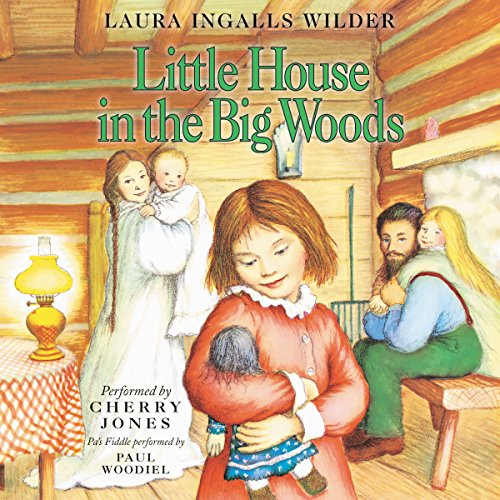Little House in the Big Woods
by Laura Ingalls Wilder
illustrated by Garth Williams
Would you like to start off 2024 with an easy book that is a quick read? Do you ever wish you could go back to a simpler time? Reading or rereading Little House in the Big Woods might be the perfect beginning for your new year. I think you’ll quickly discover, however, that although the simple times could be joyous, they were not always easy. Most things were accomplished by hand with handmade tools.
Going into town was a rare adventure to purchase the few things that could not be made but were necessary to accomplish other tasks. Gunpowder was needed for hunting to feed the family. Cloth was essential to make clothes for the family—with stitching by hand.
Items were produced by the family that we would never in 2024 consider making ourselves. After the grain harvest, straw was braided and used to make hats for everyone in the family. Every part of an animal was used for food or something utilitarian. The skills to do these things were passed down or learned for the sake of survival. There was fun and artistry to their lives as well. For example, making butter was a lengthy process with the finished product completed in a butter mold which the father (Pa) had carved with flourishes.
Laura Ingalls Wilder shares the partially fictional story of her pioneer family in their log cabin in Pepin, Wisconsin in the early 1870’s. The setting is so well described that the reader can imagine what it was really like for the main character in the story, Laura, to live during that time period. There was a lot of hard work for Ma and Pa, and they were quite isolated from any neighbors. When friends and family got together to share work, they also made a fun occasion out of the event. Although there was no church near them, the family had a ritual of Saturday night baths. They would dress in their best clothes reserved just for Sundays. Ma and Pa would read from the Bible, and they would eat cold foods. The girls had to sit quietly for most of the day. The author shares the experiences she had that were dependent on the changes of the seasons. Their lives were driven by the seasons, spending summer and fall preparing food for the winter.
Wilder gives detailed descriptions of nature and the land where they lived. She was a gifted writer and her way with words makes the reader want to keep forward motion with the story just to revel in the words. She sprinkles in stories that Pa told to Laura and her sister Mary. He was a good storyteller, singer and fiddle player. Pa and Ma were consistent and loving parents with high expectations for moral values and work ethics.
Rating: 5/5
Category: Children, Fiction. This series is generally listed as intended for children, but many adults enjoy them as well. Actually, as a culture we are so far removed from the technology and methods of work of the 1800’s that there would need to be a lot of discussion for children to understand the story.
Notes: #1 in the Little House series which has 9 books and many spin-off stories.
Publication: 1932—Harper Collins
1953—beautiful illustrations by Garth Williams
were added
Memorable Lines:
The attic was a lovely place to play. The large, round, colored pumpkins made beautiful chairs and tables. The red peppers and the onions dangled overhead. The hams and the venison hung in their paper wrappings, and all the bunches of dried herbs, the spicy herbs for cooking and the bitter herbs for medicine, gave the place a dusty-spicy smell.
They were cosy and comfortable in their little house made of logs, with the snow drifted around it and the wind crying because it could not get in by the fire.
All day the icicles fell one by one from the eaves with soft smashing and crackling sounds in the snowbanks beneath. The trees shook their wet, black branches, and chunks of snow fell down.


I remember one of my school teachers reading Little House to us in school. The thing that stuck out to me then and stick out to me now reading your post, is the grit, can-do attitude and willingness to overcome anything and everything. It really is a great little book.
LikeLiked by 1 person
My third grade teacher always read chapter books to us after lunch–Charlotte’s Web, Mr. Popper’s Penguins, etc. Your comment says it all in the importance of teachers reading to students. I agree with your comment on the book itself. These people demonstrated fortitude and values. As a society we have come a long way from those strengths.
LikeLiked by 1 person
I can’t even imagine living that kind of difficult life! I am so grateful every day for our modern creature comforts! They would be astounded to learn that when we need butter, we don’t even have to go to the store, we can have it delivered to our door!
Jenna
LikeLiked by 1 person
Yes! We have so much to be thankful for–and so much we take for granted!
LikeLiked by 1 person
I love this series, Linda! I read some of them when I was young and then read them to my kids when they were young. It has been many years since I have read this one. It is definitely worth a re-read!
LikeLiked by 1 person
Gretchen, I couldn’t agree more! I was so glad I read this book; it doesn’t even take long. It is well written and it is a timely reminder of the strength of character that was necessary to build our nation (and others) with what we call “the pioneer spirit.”
LikeLike